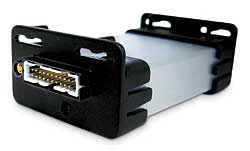Road Check
A new diagnostic/GPS device helps maintain safety in an uncertain world.
- By Marc Barrera
- Feb 01, 2007
 IN some industries, employees and equipment stay within the bounds of
their company's location and are therefore easier to supervise and
maintain. But in others, such as delivery, plumbing, taxi, and
limousine services, the very nature of the business requires workers
and equipment to leave the premises. This gives employers fewer options
toward controlling many important variables that affect safety.
IN some industries, employees and equipment stay within the bounds of
their company's location and are therefore easier to supervise and
maintain. But in others, such as delivery, plumbing, taxi, and
limousine services, the very nature of the business requires workers
and equipment to leave the premises. This gives employers fewer options
toward controlling many important variables that affect safety.
With the emergence of GPS locators, an employer does have the
ability to monitor the location of its fleet of vehicles, but not much
else. That is changing in ways employers appreciate.
Real-Time Monitoring Limits Downtime
A new PDA-sized device from Networkcar Inc. called the NetworkfleetTM
Wireless Vehicle Management System adds to the employers' monitoring
capabilities, allowing them to be proactive in maintaining safety and
efficiency. It plugs directly into a vehicle's service check connector
to monitor critical performance information.
Paul Washicko, president of Networkcar Inc., said the device's
patented technology makes it unique among its competitors because it
reads diagnostic trouble codes (DTCs) directly from a vehicle's
computer, including those still pending. This information is
immediately transmitted and made accessible through the Internet. "Our
competitors are typically location only. We have the remote diagnostics
along with that, which do factor into improving the safety of the fleet
through better maintenance and keeping the vehicle in better tune," he
said. E-mail alerts are sent to fleet managers when certain exceptions
occur, such as cylinder misfires.
Other data, such as engine temperature, air intake temperature, idle
time, and oil pressure, also are accessible to fleet managers. "For a
fleet manager, especially one with a distributed fleet, this is
extremely valuable information because they have no idea what's going
on with those vehicles that aren't physically in their location,"
Washicko said.
This real-time monitoring ability allows employers to proactively
address wear-and-tear items before they progress into much more
expensive problems that can compromise an employee's safety and the
safety of others on the road or require extended downtime for vehicle
repair. To be even more proactive, the system allows managers to
schedule maintenance alerts that follow manufacturers' recommendations,
along with any additions the customer wishes to add. To automate this
feature, odometer readings are monitored daily directly from the
vehicle's computer--eliminating the time-consuming, error-prone
practice of physically checking odometer information for each vehicle
in a fleet.
Another big safety feature is the system's automated recall tool. A
manufacturer's recall can be as minor as a bad radio dial or as serious
as faulty brakes. Networkcar monitors the National Highway Traffic
Safety Administration's Web site and posts recall alerts to the
appropriate customers.
The Human Factor
The most critical and unpredictable safety element in any vehicle
is how its driver behaves. Besides being able to optimize an employee's
daily routes, the system allows users to monitor vehicle speed, miles
per gallon, and idle time, all of which can be indicative of aggressive
or reckless driving. With this information in hand, managers can take
proper actions to correct an employee's driving habits. "The risk
management departments in these companies are very interested in this
type of data so they can reduce accidents," Washicko said. "That's a
very expensive proposition for any company, and we're seeing our
customers using this for that very reason."
Beyond safety, the service includes many additional features, such
as immediate Smart Roadside Assistance for a vehicle breakdown, Stolen
Vehicle Recovery in the event of a theft, and a remote smog check
program (currently available only in California) that exempts vehicles
from physical certification inspections.
Washicko says Networkcar will continue to add to its product and
tailor it to better suit customers' needs. Customers are giving input
on which criteria should be used to develop a driver's report card
generated from the vehicle data. Washicko said the company is taking
its time developing the report feature to ensure usefulness and
accuracy. "We don't want to unnecessarily penalize drivers or alarm
fleet managers. We need to be careful there and come up with something
that's effective to achieve what the fleet manager wants, as well as
provide value to the driver," he said, adding that the company soon
will be able to give customers a side-by-side comparison of a driver's
speed against posted speed limits.
The company is working to integrate its service into pre-existing
systems, thus letting customers continue to use what they know. "We'll
be continuing to innovate the service for them and work with the
customer base to develop a tool that is ever more useful and effective
for them," he said.
This column appeared in the February 2007 issue of Occupational Health & Safety.
This article originally appeared in the February 2007 issue of Occupational Health & Safety.